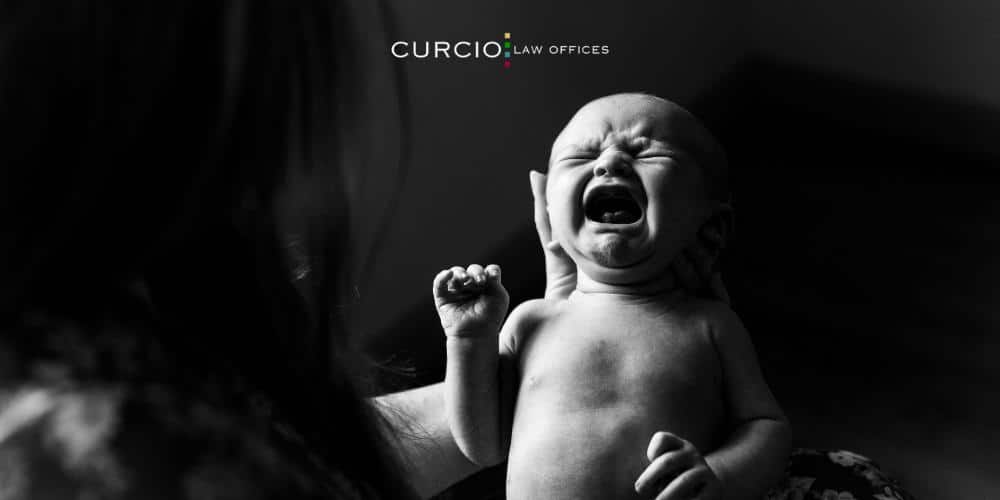CHICAGO SHOULDER DYSTOCIA ATTORNEY
PRACTICE AREAS
Chicago Shoulder Dystocia Lawyer
Giving birth is a beautiful and emotional experience for most women. But for others, it can be incredibly traumatic, especially if the child suffered injuries on its way out of the birth canal. One type of birth injury that can sometimes lead to lifelong disability for the baby is shoulder dystocia. Shoulder dystocia occurs when the baby’s shoulders get stuck inside the mother’s pelvis during childbirth. Most doctors are competent and experienced enough to notice this issue right away and provide immediate medical intervention. As long as the situation is handled properly, both mother and baby will be fine. But if medical malpractice occurs during a difficult birth involving shoulder dystocia, then both mother and baby can suffer major complications.
If you or your baby have suffered major complications due to mishandled shoulder dystocia during childbirth, you may have grounds to file a birth injury lawsuit. Call Chicago birth injury lawyers at 312-321-1111 to schedule a free consultation today.

What is Shoulder Dystocia?
Shoulder dystocia is a type of birth injury that can lead to major complications for both mother and baby without proper medical intervention. Shoulder dystocia occurs when the baby’s shoulders get caught on the mother’s pelvic bone during birth. If the doctors pull the baby’s head too hard while the baby’s shoulder is stuck, the brachial plexus nerves can become stretched and damaged. This can lead to a brachial plexus injury, which can cause lifelong pain, numbness, and tingling in the arms and fingers.
How Common is Shoulder Dystocia?
Shoulder dystocia is a fairly rare birth injury, and the chance of it occurring heavily depends on the baby’s birth weight. The CDC states that approximately 3.6 million babies are born in the U.S. every single year. The Cleveland Clinic states that shoulder dystocia occurs in 0.6% to 1.4% of these babies weighing between 5 pounds, 8 ounces and 8 pounds, 13 ounces. The chance of this birth injury occurring increases exponentially when babies weigh more than 8 pounds, 13 ounces. In fact, rates climb up to 5% to 9%.
Signs of Shoulder Dystocia
A competent medical professional should notice signs of shoulder dystocia during labor and delivery. One of the first signs that the baby’s shoulders are stuck behind the mother’s pelvis is the “turtle sign.” This occurs when the baby’s head retracts towards the perineum after it has emerged from the birth canal. Other signs of this birth injury include:
- The mother can push the baby’s head out, but cannot push the baby’s shoulder out
- More than one minute has passed since the baby’s head was delivered, but not the rest of their body
- The mother and baby need immediate medical intervention in order to complete the delivery
Is Shoulder Dystocia Preventable?
In most cases, there is no way to predict or prevent shoulder dystocia. There are a few risk factors that can possibly lead to difficulty delivering and/or shoulder dystocia, and the doctor should be able to plan accordingly due to those risk factors.
There are also ways to reduce the chances of major complications from occurring due to shoulder dystocia. With a competent healthcare provider, shoulder dystocia doesn’t have to be life-threatening and result in major birth injuries. Doctors should be able to recognize that there is a problem during vaginal delivery and then take immediate action to prevent further injury or death to the mother and baby. If this doesn’t happen, and the baby or the mother suffers major injuries, then our Chicago medical malpractice attorney can help the mother sue the doctor for medical malpractice.
Shoulder Dystocia Risk Factors
Risk factors for shoulder dystocia include:
- The baby is in the wrong position during birth.
- Fetal macrosomia, which is when the baby weighs more than 8 pounds, 13 ounces at birth.
- The mother’s pelvic opening is too small compared to the size of the baby’s head or the mother has an abnormal pelvic structure.
- The mother’s position during birth is limiting the pelvic space.
- Maternal diabetes.
- Maternal obesity.
- The mother is older than 35 years of age.
- The mother has experienced shoulder dystocia in a previous pregnancy.
- Giving birth after the due date.
If one or more of these risk factors is present before birth, the doctor should either schedule a c-section or take extra precautions in the delivery room to ensure that both mother and baby survive the birth. This is a valid reason for an emergency c-section. If the doctor fails to do this, and a major birth injury occurs as a result, they can certainly face a medical malpractice lawsuit.
Shoulder Dystocia Complications
Shoulder dystocia is a medical emergency that, when handled properly, can result in little to no injury to both mother and baby. But if medical negligence is occurring, then major complications can occur as well.
Maternal complications from shoulder dystocia can include:
- Postpartum hemorrhage (heavy bleeding after birth).
- Severe perineal tearing.
- Rectovaginal fistula which is an abnormal connection between the rectum and the vagina.
- Pubic bone separation.
- Uterine rupture.
Complications that babies can suffer due to shoulder dystocia include:
- Brachial Plexus Palsy is also known as Erb’s palsy. This is a type of nerve damage in the neck and arms. The brachial plexus nerves branch off from the cervical portion of the spinal cord and down the arms. If these nerves are stretched or torn during birth, babies can suffer weakness, paralysis, tingling, and pain in one or both arms. Our Chicago Erb's Palsy lawyers have extensive experience navigating Chicago paralysis lawsuits.
- Fractures: The baby’s collarbone and upper arm bones can break due to shoulder dystocia.
- Umbilical Cord Compression: While this is a rare complication of shoulder dystocia, it can happen. If the umbilical cord is compressed between the baby’s arm and the mother’s pelvic bone, the baby won’t receive enough oxygen and blood during birth. If this isn’t handled immediately, the baby can suffer permanent brain damage and/or a brain injury such as cerebral palsy. An experienced Chicago cerebral palsy lawyer can help you determine whether you have enough evidence to file a Chicago brain injury lawsuit.
- Horner’s Syndrome is a rare condition that affects the face and eye on only one side. The syndrome is caused by nerve pathway disruption from the brain to the head and neck. Symptoms include small pupil size, a drooping eyelid, and little to no sweating on one side of the face.
Some of these complications can lead to lifelong pain and disability for the baby. If you or your baby has suffered from one of the aforementioned shoulder dystocia complications, you may have grounds to file a birth injury claim.

Shoulder Dystocia Maneuvers
So, how is shoulder dystocia treated during labor and delivery? Once the medical team recognizes one or more signs of shoulder dystocia, they may follow the HELPERR method:
- Help: The doctor will call for more help and extra equipment during labor and delivery.
- Evaluate for Episiotomy: The doctor will decide if an episiotomy is necessary to deliver the baby. An episiotomy is basically a perineal incision in order to create a larger vaginal opening. This incision can lead to excess pain and other health issues for the mother, so an episiotomy should only happen if the doctor needs more vaginal space to rotate the baby.
- Legs: The doctor may ask the mother to press her legs against her stomach in order to flatten and rotate the pelvis. This is called the McRoberts Maneuver.
- Pressure: The doctor may then press on the mother’s lower abdomen above the pubic bone in an attempt to rotate the baby’s shoulder. This can help the baby get “unstuck” and delivered safely.
- Enter Maneuvers: If suprapubic pressure has not been successful, the doctor will then reach inside the birth canal in order to rotate the baby’s shoulders.
- Remove Posterior Arm: Next, the doctor will pull one of the baby’s arms out of the birth canal which can make it easier to free the shoulders. This is called the Jacquemier’s maneuver.
- Roll: Finally, the doctor will ask the mother to roll onto her hands and knees in order to fully deliver the baby.
If the HELPERR method is unsuccessful, the doctor will resort to a c-section or one of the following birthing methods:
- Clavicle Fracture: The doctor will break the baby’s collarbone in order to free the shoulders from the pelvic bone.
- Symphysiotomy: The doctor will cut the cartilage between the pelvic bones in order to make the pelvic opening bigger and safely deliver the baby.
Can You Sue for Shoulder Dystocia in a Newborn?
If your case of shoulder dystocia resulted in major maternal and fetal complications – such as hemorrhage, uterine rupture, oxygen deprivation, or brain damage – then you may have grounds to file a birth injury lawsuit.
Sometimes, doctors can take every precaution before birth and do everything right during birth, and birth injuries still occur anyway. But most of the time, birth injuries occur due to the negligent actions and inactions of medical professionals. If your doctor noticed multiple risk factors prior to birth and failed to schedule a c section or adequately prepare for a complicated vaginal birth, they could face a medical malpractice lawsuit. If your medical records prove that the doctors did not take the proper steps to handle your shoulder dystocia during birth, then they could also face a medical malpractice lawsuit.
A Chicago birth injury attorney at Curcio & Casciato has what it takes to analyze the details of your case and help you determine whether medical negligence was at play. From there, we can hire medical expert witnesses from the Chicagoland area to confirm whether or not the doctor failed to take proper care before and during birth. Lastly, we can help you recover maximum financial compensation for your and your child’s injuries.
Birth Injury Damages
A Chicago birth injury lawyer can help you recover financial compensation for the following types of damages:
- Past and future medical expenses
- Past and future rehabilitative expenses
- Expenses for necessary medical equipment such as wheelchairs and braces (if the child is permanently disabled)
- Lost wages
- Loss of earning capacity (if your child’s disability will prevent them from working in the future)
- Emotional distress
- Physical pain and suffering
- Permanent disability (for the child)
- Mental health counseling costs
- Funeral and burial expenses if the birth injury results in fetal death
An experienced Chicago mental distress lawyer can show you how to determine pain and suffering and help you calculate lost income.
Illinois Statute of Limitations for Birth Injuries
The medical malpractice statute of limitations in Illinois is two years. However, birth injury cases can be filed within eight years of the incident or before the child turns 22 years old. If you’re unsure whether the statute of limitations for your birth injury claim has passed, please speak to an experienced Chicago birth injury lawyer at Curcio & Casciato.

Call a Chicago Shoulder Dystocia Lawyer at Curcio & Casciato Today
Birth injuries are incredibly devastating. We have seen families struggle physically, emotionally, and financially for years after the birth injury occurred. If medical errors directly caused the birth injury, then the family definitely has grounds to take legal action against the doctor or hospital. Chicago birth injury attorneys can help you determine whether or not you have grounds to sue, how much compensation you could possibly receive, and so much more.
We have a proven track record of success in litigating birth injury lawsuits. Don’t believe us? Check out our verdicts. Then, call our law firm at 312-321-1111 to schedule a free case review.


